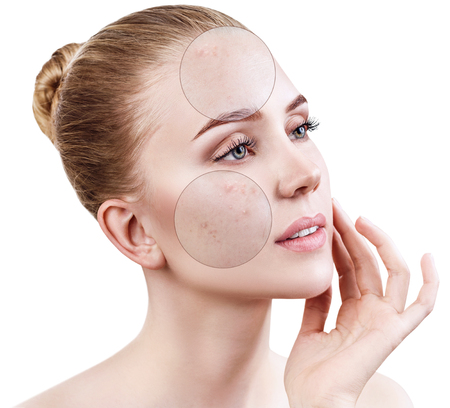1. Introduction to Chemical Peels
Chemical peels have become a go-to treatment in anti-aging skincare routines across the United States. These treatments use specially formulated chemical solutions to remove the outermost layers of skin, revealing fresher, smoother, and more youthful-looking skin underneath. As more Americans look for non-invasive ways to maintain a youthful glow, chemical peels are gaining popularity in dermatology clinics, med spas, and even at-home skincare regimens.
What Are Chemical Peels?
A chemical peel is a cosmetic procedure where a solution is applied to the skin, causing it to exfoliate and eventually peel off. This process helps reduce visible signs of aging like fine lines, wrinkles, sun damage, and uneven skin tone. There are various types of peels available, each designed for different skin concerns and depths of penetration.
Types of Chemical Peels
| Type | Description | Common Uses |
|---|---|---|
| Superficial (Light) Peel | Uses mild acids like alpha-hydroxy acid (AHA) | Brightening, mild texture improvement |
| Medium Peel | Uses stronger acids such as trichloroacetic acid (TCA) | Treats fine lines, age spots, moderate discoloration |
| Deep Peel | Uses phenol or high-strength TCA | Smooths deep wrinkles and severe sun damage |
The Rise of Chemical Peels in the U.S.
In recent years, American consumers have embraced chemical peels as part of their regular anti-aging strategy. From celebrities sharing their peel experiences on social media to dermatologists recommending them as effective alternatives to lasers or injections, these treatments are now mainstream. Many people appreciate that chemical peels offer noticeable results with minimal downtime and can be tailored to suit individual skin types and concerns.
2. How Chemical Peels Combat Signs of Aging
Chemical peels have become a popular choice in the U.S. for people wanting to refresh their appearance and tackle common signs of aging. These treatments use carefully formulated solutions to remove the top layers of skin, revealing fresher, younger-looking skin underneath. But how exactly do they help with things like fine lines, wrinkles, and uneven skin tone? Let’s break it down.
How Chemical Peels Work
During a chemical peel, a solution is applied to your face (or another area) that causes the outermost layer of skin to exfoliate and eventually peel off. This process boosts cell turnover, encourages new collagen production, and makes your skin look smoother and brighter.
Main Signs of Aging Addressed by Chemical Peels
| Sign of Aging | How Chemical Peels Help |
|---|---|
| Fine Lines & Wrinkles | Chemical peels smooth the surface by removing damaged outer layers and stimulating collagen growth, which helps soften the look of lines and wrinkles. |
| Uneven Skin Tone | Peels fade dark spots and sun damage by encouraging new, evenly pigmented skin to emerge. |
| Dullness | The exfoliation process reveals brighter skin underneath for a natural glow. |
| Rough Texture | Chemical peels refine texture by sloughing off dead skin cells, leaving skin feeling softer and more even. |
| Mild Scarring (like acne scars) | Superficial scars can be minimized as peels promote healthy cell turnover and smoother skin. |
Types of Peels for Anti-Aging Benefits
There are different strengths and types of chemical peels used in anti-aging skincare:
- Superficial Peels: Use mild acids like glycolic or salicylic acid; best for gentle brightening and smoothing.
- Medium Peels: Often use trichloroacetic acid (TCA); target deeper wrinkles, pigmentation, and more stubborn signs of aging.
- Deep Peels: Use stronger acids like phenol; reserved for significant wrinkles and sun damage but require more downtime.
A Friendly Note on Safety
Chemical peels should always be performed by a licensed professional, especially if you’re looking to address aging concerns. Your provider will recommend the right type based on your skin goals and health history to make sure you get safe, effective results.
![]()
3. Types of Chemical Peels Commonly Used in the U.S.
Chemical peels are a popular option in anti-aging skincare routines across the United States. They work by removing the top layers of skin, revealing fresher, smoother, and more youthful-looking skin underneath. There are three main types of chemical peels—light, medium, and deep—each with different strengths and ingredients. Here’s a simple breakdown to help you understand which peel might be right for different skin concerns:
| Type | Main Ingredients | Depth | What It Treats | Downtime |
|---|---|---|---|---|
| Light Peel | Glycolic acid, Salicylic acid | Superficial (outermost layer) | Fine lines, mild discoloration, acne | Little to none (mild redness) |
| Medium Peel | TCA (Trichloroacetic Acid) | Middle layers of skin | Wrinkles, age spots, moderate sun damage | A few days (peeling & redness) |
| Deep Peel | Phenol | Deeper layers of skin | Deep wrinkles, significant sun damage, scars | Several weeks (significant peeling & recovery) |
Light Peels: Gentle Rejuvenation
Light peels are often called “lunchtime peels” because they’re quick and require little to no downtime. Glycolic acid (from sugar cane) and salicylic acid (great for oily or acne-prone skin) are common ingredients. These peels gently exfoliate the skin’s surface to improve texture and brightness.
Medium Peels: A Step Deeper for Visible Results
If you want more noticeable results but aren’t ready for a deep peel, medium peels using TCA (trichloroacetic acid) can help reduce wrinkles, age spots, and uneven tone. You’ll likely experience some redness and flaking that lasts a few days as your skin heals.
Deep Peels: Dramatic Transformations
Deep peels use phenol and penetrate several layers of skin. They offer dramatic results for deeper wrinkles and severe sun damage but require more recovery time. These peels are usually performed by experienced professionals and may need anesthesia or sedation.
Choosing the Right Peel for Anti-Aging Goals
The choice between light, medium, and deep peels depends on your specific skin concerns, how much downtime you can handle, and your desired results. Always consult with a licensed skincare professional to find the safest and most effective treatment plan for your unique needs.
4. What to Expect: The Procedure and Downtime
The Chemical Peel Experience
For many Americans interested in anti-aging skincare, chemical peels are a popular choice to address fine lines, wrinkles, sun damage, and uneven skin tone. Here’s what you can expect during a typical chemical peel procedure:
Step-by-Step Procedure Overview
| Step | What Happens |
|---|---|
| Consultation | Your provider evaluates your skin type, discusses your goals, and selects the right peel for you (light, medium, or deep). |
| Cleansing | The skin is thoroughly cleansed to remove oil, makeup, and impurities. |
| Application | The chemical solution is carefully applied to your face. You might feel tingling or mild stinging as it works. |
| Neutralization & Removal | Depending on the type of peel, the solution may be left on for a set time or neutralized and removed by your provider. |
| Aftercare | A soothing ointment or sunscreen is applied. Your provider explains post-peel care instructions. |
Downtime and Recovery: What Americans Typically Expect
Chemical peels vary in strength, so recovery times differ. Most people want to know how long they’ll need before returning to work or social activities. Here’s a breakdown:
| Type of Peel | Downtime (Recovery Time) | Common Side Effects | Back-to-Normal Activities |
|---|---|---|---|
| Light Peel (Superficial) | No downtime to 1 day; mild redness or flaking. | Slight dryness, light peeling. | Immediately to next day. |
| Medium Peel | 3-7 days; moderate peeling and redness. | Redness, swelling, visible peeling. | Usually within a week. |
| Deep Peel | Up to 2 weeks; significant peeling and sensitivity. | Strong redness, swelling, scabbing possible. | After 2 weeks or more with follow-up care. |
Treatment Tips from American Providers
- Avoid sun exposure after your peel—use SPF daily.
- No picking or scrubbing peeling skin; let it shed naturally.
- Stick to gentle cleansers and moisturizers recommended by your provider.
- You may need several treatments for best results with lighter peels.
- If you’re prepping for an event (like a wedding), plan peels at least a few weeks ahead!
5. Benefits, Risks, and Aftercare Tips
Benefits of Chemical Peels in Anti-Aging Skincare
Chemical peels are a popular anti-aging treatment in the U.S., recommended by dermatologists for their ability to refresh and rejuvenate the skin. Here are some key advantages:
| Benefit | Description |
|---|---|
| Smoother Skin Texture | Peels remove dead skin cells, revealing softer, smoother skin underneath. |
| Reduction of Fine Lines and Wrinkles | Chemical exfoliation encourages new cell growth, helping to minimize fine lines. |
| Even Skin Tone | Peels can fade dark spots, sun damage, and discoloration for a more uniform complexion. |
| Brighter Appearance | The removal of dull surface cells gives the skin a healthy, radiant glow. |
| Boosted Collagen Production | Stimulates collagen renewal, which is essential for youthful-looking skin. |
Risks and Possible Side Effects
While chemical peels offer many benefits, it’s important to be aware of potential side effects. U.S. dermatologists emphasize the following risks:
- Redness and Irritation: It’s common to experience some redness or sensitivity after a peel.
- Flaking and Peeling: The skin may peel or flake for several days post-treatment.
- Temporary Darkening or Lightening: Some people notice changes in pigmentation, especially with deeper peels.
- Sensitivity to Sunlight: Skin becomes more sensitive to UV rays and needs extra protection.
- Infection or Scarring (Rare): More likely if aftercare instructions aren’t followed closely or if performed by an unqualified provider.
Aftercare Tips Recommended by U.S. Dermatologists
Proper aftercare is crucial for healing and maximizing results. Here’s what experts commonly advise:
| Aftercare Tip | Description/How-To |
|---|---|
| Avoid Sun Exposure | Stay out of direct sunlight; always use broad-spectrum SPF 30 or higher. |
| No Picking or Scrubbing | Let your skin shed naturally; picking can cause scarring or infection. |
| Mild Cleansers Only | Use gentle, fragrance-free cleansers—avoid harsh soaps or exfoliants. |
| Moisturize Regularly | Apply a fragrance-free moisturizer to prevent dryness and aid healing. |
| Avoid Makeup (Initially) | Skip makeup for at least 24 hours or as advised by your dermatologist. |
| Follow Provider Instructions | Your dermatologist may recommend specific products or routines tailored to your peel type and skin needs. |
If You Experience Any Unusual Symptoms…
If you notice signs of infection (such as pus, extreme redness, or swelling), contact your dermatologist promptly. Most side effects are mild and temporary when proper aftercare is followed. Taking these steps will help ensure your skin heals beautifully—and you get the most from your chemical peel treatment!


